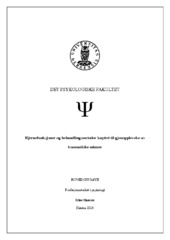Hjernefunksjoner og behandlingsmetoder knyttet til gjenopplevelse av traumatiske minner
Master thesis
Permanent lenke
https://hdl.handle.net/1956/18989Utgivelsesdato
2018Metadata
Vis full innførselSamlinger
- Faculty of Psychology [527]
Sammendrag
This paper seeks to explore the theory and the empirical evidence of the destabilization in the communication between the separate parts of the brain engaged in establishing memories in people exposed to traumatic events. The memory consolidation process and the integration are disrupted and will lead to an ongoing maintenance in episodic and fragmented memories, which in turn leads to suffering. In the preparation for trauma treatment a stage of affective stabilization is necessary to expand the window of tolerance without hypo- or hyper arousal. Expansion of the window of tolerance may occur by increased body consciousness, identification of one’s own feelings, and psychoeducation in a safe environment. Several studies have shown that exposure for traumatic memories is effective in treating posttraumatic stress disorder and intrusive memories. Three methods with the purpose of reducing intrusive memories and emotional distress will be discussed, in relation to neurological processes and emotional stabilization; exposure-based interventions (EBI), Eye Movement Desensitization and Reprocessing (EMDR), and Brain Working Recursive Therapy (BWRT). Formålet med denne oppgaven er ut fra teori og forskning å undersøke forstyrrelser som oppstår i kommunikasjonen mellom delene i hjernen som etablerer minner hos personer utsatt for en traumatisk hendelse. Når den normale minnekonsolideringsprosessen og integreringen bryter sammen, vil det kunne lede til en pågående opprettholdelse av episodiske og fragmenterte minner, som igjen leder til lidelse. Før minnebearbeidingen kan starte vil traumebehandlingen først innebære en fase med emosjonell stabilisering med hensikt å utvide tålegrensen til klienten, uten at overaktivering eller underaktivering skjer. Utvidelse av toleransevindu kan oppstå i form av økt kroppsbevissthet, identifisering av egne følelser og psykoedukasjon i trygge omgivelser. Flere studier har vist at eksponering for de traumatiske minnene er effektivt for bedring av posttraumatiske stresslidelse og påfølgende invaderende minner. Tre metoder med formål om å redusere invaderende minner og emosjonelt ubehag vil bli drøftet opp imot nevrologiske prosesser og emosjonell stabilisering: eksponeringsbaserte intervensjoner (EBI), Eye Movement Desensitization and Reprocessing (EMDR), og Brain Working Recursive Therapy (BWRT).
